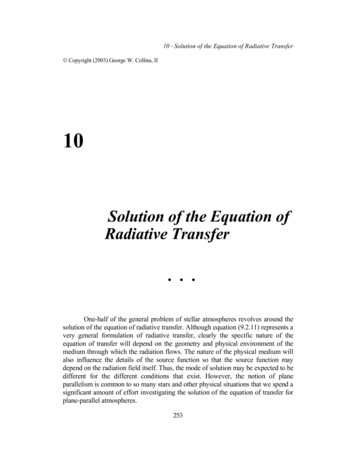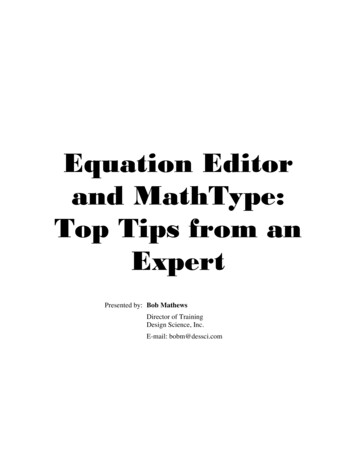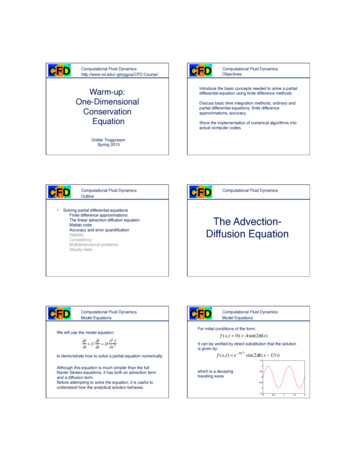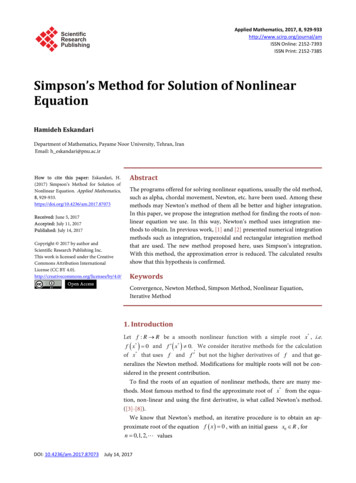
Transcription
10 Solution of the Equation of Radiative Transfer Copyright (2003) George W. Collins, II10Solution of the Equation ofRadiative Transfer. . .One-half of the general problem of stellar atmospheres revolves around thesolution of the equation of radiative transfer. Although equation (9.2.11) represents avery general formulation of radiative transfer, clearly the specific nature of theequation of transfer will depend on the geometry and physical environment of themedium through which the radiation flows. The nature of the physical medium willalso influence the details of the source function so that the source function maydepend on the radiation field itself. Thus, the mode of solution may be expected to bedifferent for the different conditions that exist. However, the notion of planeparallelism is common to so many stars and other physical situations that we spend asignificant amount of effort investigating the solution of the equation of transfer forplane-parallel atmospheres.253
II Stellar Atmospheres10.1 Classical Solution to the Equation of Radiative Transfer andIntegral Equations for the Source FunctionThere are basically two schools of approach to the solution of theequation of transfer. One involves the solution of an integral equation for the sourcefunction, while the other deals directly with the differential equation of transfer. Bothhave their merits and drawbacks. Since both are widely used, we give examples ofeach. Both involve the classical solution, so that we begin the discussion with thatsolution.aClassical Solution of the Equation of Transfer for the PlaneParallel AtmosphereThe equation of transfer is a linear differential equation, whichimplies that a formal solution exists for the radiation field in terms of the sourcefunction. This linear property is a marked difference from the situation in stellarinteriors where the structure equations were all highly nonlinear. Although undersome conditions the solution [i.e., Iν(τν,µ)] itself is involved in the source function,this involvement is still linear. Let us consider a fairly general equation of radiativetransfer for a plane-parallel atmosphere, but one where we may neglect timedependent effects and the presence of the potential gradient on the radiation field.(10.1.1)Since this equation is linear in Iν(τν,µ), we may write the complete solution as thesum of the solution to the homogeneous equation plus any particular solution. So letus choose as homogeneous and particular solutions(10.1.2)Substitution into the equation of transfer places constraints on c1 and f'’(τν), namely(10.1.3)While we have assumed that the geometry of the atmosphere is planeparallel, we have not yet specified the extent of the atmosphere. For the moment, letus assume that the atmosphere consists of a finite slab of thickness τ0 (see Figure10.1). The general classical solution for the plane-parallel slab is then(10.1.4)254
10 Solution of the Equation of Radiative TransferFigure 10.1 shows the geometry for a plane-parallel slab. Note that thereare inward (µ 0) and outward (µ 0) directed streams of radiation. Theboundary conditions necessary for the solution are specified at τν 0, andτν τ0 .Since the equation of transfer is a first order linear equation, only oneconstant must be specified by the boundary conditions. However, even though thedepth variable τν is the only independent variable that appears in a derivative, wemust always remember that Iν(τν,µ) is a function of the angular variable µ. Thus ingeneral, the constant of integration c2 will depend on the direction taken by theradiation. For radiation flowing outward in the atmosphere (that is, µ 0), theconstant c2 will be set equal to the radiation field at the base of the atmosphere [thatis, Iν(µ, τ0)] and the integral will include the contribution from the source functionfrom all depths ranging from τ0 to the point of interest τν. If we were concernedabout radiation flowing into the atmosphere (that is, µ 0), then the integral inequation (10.1.4) would cover the interval from 0 to τν and c2 would be chosen equalto the incident radiation field [Iν(-µ,0)].At this point we encounter one of the notational problems that often leads toconfusion in understanding the literature in radiative transfer. For most problems instellar atmospheres, there is a significant difference between the radiation fieldrepresented by the inward-directed streams of radiation and that represented by thoseflowing outward. In modeling the normal stellar atmosphere, there is no incidentradiation present so that the incident intensity Iν(-µ,0) 0. However, the outward255
II Stellar Atmospheresdirected streams always result from a lower boundary condition which is nonzero.Thus it is useful to distinguish between the inward- and outward-directed streams insome notational way. We have already used a standard method of indicating thisdifference; namely, we explicitly labeled the inward-directed streams by -µ. Thus,we usually regard the angular variable m as an intrinsically positive quantity that isbounded by0 µ 1. The sign of m must then be explicitly indicated, and we dothis when we use this convention. Thus, to gain a physical understanding of themeaning of any solution for the radiation field, one must always keep in mind whichstreams of radiation are being considered.The general classical solution for the two streams can then be written as(10.1.5)While τν represents the vertical depth in the atmosphere increasing inward, τν/µ isthe actual path along the direction taken by the radiation. In general, extinction byscattering or absorption will exponentially diminish the strength of the intensity bye -τ/µ . Since the source function represents the local source of photons from allprocesses, and since it is attenuated by the optical distance along the path of theradiation, the integrand of the integral represents the local contribution of the sourcefunction to the value of the intensity at τν. The remaining term simply represents thelocal contribution to the specific intensity of the attenuated incident radiation.One further complication must be dealt with before we can use thisdescription of a stellar atmosphere. In general, stellar atmospheres can be regarded asbeing infinitely thick. Since the influence of the lower boundary diminishes as eτ -τ 0 ,and since this optical depth will exceed several hundred within a few thousandkilometers of the surface for main sequence stars, we can take it to be infinity. Inaddition, we should require the radiative flux to be finite everywhere. This will forcethe constant c2 in equation (10.1.4) to vanish. Furthermore, the surface is generallyunilluminated. So we can write the classical solution for the semi-infinite planeparallel atmosphere as(10.1.6)256
10 Solution of the Equation of Radiative TransferbSchwarzschild-Milne Integral EquationsOne reason that the equation of transfer admits such a simple solutioncompared to the equations of stellar structure is that we have confined most of thedifficult physics to the source function. What is left is largely geometry and henceaffords a simple solution. However, the classical solution does allow for thegeneration of the entire radiation field should it be possible to specify the sourcefunction. It also allows us to remove the explicit structure of the radiation field and togenerate an expression for the source function itself. The result is an integralequation, that is, an equation where the unknown appears under the integral sign aswell as outside it.While much attention has been paid to the solution of differential equations,far less has been given to integral equations. However, it is very often numericallymore efficient and accurate to solve an integral equation as opposed to thecorresponding differential equation. Therefore, we spend some time and effort withthese integral equations, for they provide a very productive path toward the solutionof problems in radiative transfer.Integral Equation for the Source Function In Chapter 9 we showed that, forcoherent isotropic scattering, we could write a quite general expression for the sourcefunction [equation (9.2.33)]. If we re-express that result in terms of the meanintensity, we get(10.1.7)where(10.1.8)Now the role of the classical solution becomes evident. The source function containsthe mean intensity Jν(τν), which can be generated from the classical solution thatcontains the source function itself. Thus, if we substitute the classical solution[equation (10.1.6)] into the definition for Jν(τν) [equation (9.3.2)], we get(10.1.9)257
II Stellar AtmospheresNow notice that the argument of the exponential is always negative and thatthe two integrals over t are contiguous. Thus, we can combine these integrals into asingle integral that ranges from 0 to 4. In addition, t and µ are independent variablesso that we may interchange the order of integration and get(10.1.10)The quantity in brackets is a well-known function in mathematical physics known asthe exponential integral. It depends only on the independent variables of theproblem and therefore can be regarded as a largely geometric function. Its formaldefinition is(10.1.11)and when expressed by the final integral, it has the same form as the integral inbrackets in equation (10.1.10). While the exponential integral may not be terriblyfamiliar, it should be regarded with no more fear and trepidation than sines andcosines. There is an entire set of these functions where each member is denoted by n,and they have a single argument, which for our purposes will be confined to the realline. These functions (except for the first exponential integral at the origin) are wellbehaved and resemble e-x/(nx) for large x. Some useful properties of exponentialintegrals are(10.1.12)Making use of the first exponential integral, we can rewrite our expressionfor the mean intensity [equation (10.1.10)] as(10.1.13)Combining this with equation (10.1.7) for the source function, we arrive at thedesired integral equation for the source function:(10.1.14)Any function that multiplies the unknown in the integrand of an integral equation iscalled the kernel of the integral equation. Thus, the first exponential integral is thekernel of the integral equation for the source function. The connection between the258
10 Solution of the Equation of Radiative Transferphysical state of the gas and the source function is contained in the term that makesthe equation inhomogeneous, namely, the one involving the Planck functionBν[T(τν)]. A solution of this equation, when combined with the classical solution,will yield the full solution to the radiative transfer problem since Iν(µ, τν) will bespecified for all values of µ and τν.It is possible to understand equation (10.1.14) from a physical standpoint.Now ε(τν) is the fraction of locally generated photons that arise from thermalprocesses, so that the first term is simply the local contribution to the source functionfrom thermal properties of the gas. The second term represents the contribution fromscattering. We have already said that a fundamental aspect of stellar atmospheres isthe dependence of the local radiation field on the global solution for the radiationfield. Nowhere is this more clearly demonstrated than in this term. The scatteringcontribution to the source function is made up of contributions from the sourcefunction throughout the atmosphere. However, these contributions decline withincreasing distance from the point of interest, and they decline roughly exponentially.One may object that this integral equation is a very specialized equation sinceit relies on the source function's being expressible in terms of the mean intensity andtherefore is valid only for isotropic scattering. However, consider the very generalexpression for the source function given by equation (9.2.27). As long as the angulardependence of the redistribution function is known, it will be possible to carry outthe integrals over solid angle and express the source function as a combination of themoments of the radiation field. As long as this can be done, the appropriate momentscan be generated from the classical solution for the equation of transfer which will, inturn, involve only the source function. Thus, the moments can be eliminated from themoment expression for the source function, yielding an integral equation. To be sure,this will be a more complicated integral equation, but it will still be solvable by thesame techniques that we apply to equation (10.1.14). Thus, the existence of anintegral equation for the source function is a quite general result and represents theseparation of the depth dependence of the radiation field from the angulardependence, which can be obtained from the classical solution.Integral Equations for Moments of the Radiation Field Useful as theintegral equation for the source function is, it is often convenient to have similarexpressions for the moments of the radiation field. We should not be surprised thatsuch expressions exist since the angular moments are free, by definition, of theangular dependence characteristic of the classical solution. Indeed, we have alreadysupplied the required expressions to obtain an integral equation for the meanintensity. We simply use equation (10.1.7) to eliminate Sν(t) from equation (10.1.13),and we have259
II Stellar Atmospheres(10.1.15)It is now clear how to develop similar expressions for the remaining moments, sinceequation (10.1.13) was obtained by taking moments of the classical solution to theequation of transfer. Let us define an operator which is commonly used to representthis process.(10.1.16)The Λn operator is an integral operator which operates on a function byemploying an exponential integral kernel. The term in large parentheses simplydenotes the sign of the kernel throughout the region. With this integral operator, wecan express the first three moments of the radiation field in terms of the sourcefunction as follows:(10.1.17)Such equations are known as Schwarzschild-Milne type of equations and areextremely useful for the construction of model stellar atmospheres. For example,consider the condition of radiative equilibrium where it is necessary to know theradiative flux throughout the atmosphere, but not the complete radiation field. Thisinformation can be obtained directly with the aid of the flux equation of equations(10.1.17) and the source function. Thus, determination of the source functionprovides a complete solution of the radiative transfer problem.cLimb-darkening in a Stellar AtmosphereThere is one property of the classical solution of the equation oftransfer that we should address before moving on. If we consider the classicalsolution for the emergent intensity, we see that it basically represents the Laplacetransform of the source function, namely(10.1.18)where ℒ [S(t)] is the Laplace transform of the source function. Thus determination ofthe angular distribution of the emergent intensity is equivalent to determining thebehavior of the source function with depth. Since the source function is determinedby the temperature, determination of the depth dependence of the source function is260
10 Solution of the Equation of Radiative Transferequivalent to determining the depth dependence of the temperature. This is ofconsiderable significance for stars where this dependence can be measured directlyfor it provides a direct observational check on the models of those stellaratmospheres.If we anticipate some later results and assume that the source function can beapproximated by(10.1.19)then(10.1.20)Thus, the coefficient a that multiplies the angular parameter µ in the emergentintensity is a direct measure of the source function gradient, while the constant termb denotes the value of the source function at the boundary. The decrease inbrightness as one approaches the limb of the apparent stellar disk implied byequation (10.1.20) is called limb-darkening. Since for spherical stars the variationacross the apparent disk is the same as the local angular dependence of the emergentintensity, measurement of the limb-darkening coefficient a yields a measurement ofthe source function gradient. This is of particular interest for the sun where suchmeasurements are possible. Unfortunately, the poorest theoretical representation ofthe model atmosphere occurs near the surface, and this corresponds to just thatregion of the stellar disk (i.e., near the limb where µ 0) where confirmatorymeasurements are most difficult to make. Although we have made an approximationto the depth dependence of the source function in equation (10.1.19), theapproximation is unnecessary and more rigorous studies of this depth dependencewould deal directly with the Laplace transform itself as given by equation (10.1.18).We have now compiled methods by which we can theoretically relate the emergentintensity to the source function and provided a potential observational method toverify our result. However, before discussing methods for the solution for theintegral equation for the source function [equation (10.1.14)] we consider thesolutions to a somewhat simpler problem, in order to gain an appreciation for thebehavior of these solutions.Empirical Determination of T(τν ) for the SunIn the sun and someeclipsing binary stars, it is possible to determine the variation of the specific intensityacross the apparent disk. If we approximate that variation by(10.1.21)we can use equation (10.1.18) to obtain a power series representation of the source261
II Stellar Atmospheresfunction with optical depth. Let us further assume that the source function can berepresented by the Planck function, which in turn can be expanded in a power seriesin the optical depth so that(10.1.22)Then the substitution of this power series representation into equation (10.1.18)yields(10.1.23)Since for the sun, the ai's and Iν(0,1) may be determined from observation, the bi'smay be regarded as known. Thus, the temperature variation with monochromaticoptical depth may be recovered from10.1.24)In the sun, the assumption that Sν(τν) Bν(τν) is a particularly good one, so that forthe sun the optical depth variation of the temperature can be determined with thesame sort of accuracy that attends the determination of the limb-darkening.Empirical Determination of κ(τ1) / κ(τ2) for the Sun This type of analysiscan be continued under the above assumptions to obtain the variation with opticaldepth of the ratio of two monochromatic absorption coefficients. Since by definition(10.1.25)the ratio of two monochromatic optical depths is(10.1.26)Differentiating equation (10.1.22) with respect to temperature and substituting theresult into equation (10.1.26), we get(10.1.27)Thus it is possible to determine the approximate wavelength dependence of theopacity for stars like the sun from the observed limb-darkening. Such observationsprovide a valuable check on the theory of stellar atmospheres.262
10 Solution of the Equation of Radiative Transfer10.2 Gray AtmosphereFor the better part of this century, theoretical astrophysicists have beenconcerned with the solution to an idealized radiative transfer problem known as thegray atmosphere. Although it is an idealized situation, it has some counterparts innature. In addition, this problem possesses the virtue that a complete solution can beobtained for the radiation field without recourse to the physical details of theatmosphere. In this regard, the gray atmosphere model is rather like polytropicmodels for stellar interiors. As was the case for polytropes and stellar interiors, wemay expect to gain significant insight into the properties of stellar atmospheres byunderstanding the solution to the gray atmosphere problem. The additionalassumption required to turn our study of radiative transfer into that of a grayatmosphere is simple. Assume that the opacity, whether it is absorption or scattering,is independent of frequency. Thus, any frequency can be treated as any otherfrequency, as far as the radiative transfer is concerned. This independence of theradiative transfer from frequency has the interesting consequence that themathematical solution to the equation of transfer for any frequency will be thesolution for all frequencies, and thus must be the solution for the sum of allfrequencies. Hence, the aspect of the solution that specifies the radiative flux alsorefers to the total flux, making the condition of radiative equilibrium relativelysimple to apply. Since all aspects of the mathematical description are independent offrequency, we drop the subscript n for the balance of this discussion.Knowing what we do about the physical processes of absorption, it isreasonable to ask if the gray atmosphere is anything more than an interestingmathematical exercise. Certainly bound-bound transitions are anything but gray.However, there are some bound-free transitions that exhibit only weak frequencydependence over substantial regions of the spectrum. If those regions of the spectrumcorrespond to that part of the spectrum containing most of the radiant flux, then theatmosphere will be very similar to a gray atmosphere. Absorption due to the H-minusion is relatively frequency-independent throughout the visible part of the spectrumand in some stars is the dominant source of opacity. However, the premier exampleof a gray opacity source is electron scattering. Thomson scattering by free electronsis frequency-independent by definition, and for stars hotter than about 25,000 K, it isthe dominant source of opacity throughout the range of wavelengths encompassingthe maximum flow of energy. Thus, the early O and B stars have atmospheres that, toa very high degree, may be regarded as gray.Since frequency dependence has been removed from the problem, we maywrite the equation of radiative transfer for a plane-parallel static atmosphere as263
II Stellar Atmospheres(10.2.1)where, for isotropic coherent scattering, the source function is(10.2.2)Now the independence of the opacity on frequency makes the condition of radiativeequilibrium given by equation (9.4.4) particularly simple.(10.2.3)or simply(10.2.4)Substitution of this result into equation (10.2.2) yields(10.2.5)The fact that the mean intensity is equal to the Planck function and that either can betaken to be the source function has the interesting result that the solution to the grayatmosphere is independent of the relative roles of scattering and absorption. Thus,the radiation field for a pure absorbing gray atmosphere, where the source function isclearly the Planck function, will be indistinguishable from the radiation field of apure scattering gray atmosphere. In addition, since there is a general independenceon frequency, the spectral energy distribution will be that resulting from a grayatmosphere where the source function is the Planck function.The gray atmosphere implies that all the development of Chapters 9 and 10will apply at each frequency. This is indeed the easiest way to obtain equations(10.2.1) through (10.2.4). But there is much more. The integral equation for thesource function [equation (10.1.14)] and that for the moments of the radiation field[equations (10.1.17)] become(10.2.6)Solution of these equations, combined with the classical solution to the equation of264
10 Solution of the Equation of Radiative Transfertransfer, yields a complete description for the radiation field at all depths in theatmosphere. The method of solution for the gray atmosphere equation of transfer isalso illustrative of the methods of solution for the more general nongray problem.aSolution of Schwarzschild-Milne Equations for the GrayAtmosphereIn general, an accurate solution of these equations must be accomplishednumerically because the solution, even for the gray atmosphere, is not analyticeverywhere. Particular care must be taken with these equations because the firstexponential integral behaves badly as its argument approaches zero. Specifically(10.2.7)Thus, the kernel of first two of equations (10.2.6) has a singularity when t τ.However, this singularity is integrated over, and the integral is finite and wellbehaved. For years this singularity was regarded as an insurmountable barrier, andinterest in the solution of the integral equations of radiative transfer languished infavor of more direct methods applicable to the differential equation of transfer itself.However, the singularity of the kernel is not an essential one and may be easilyremoved. Simply adding and subtracting the solution B(τ) from the right-hand sideof the first of equations (10.2.6) yields(10.2.8)The integrand of the first of these integrals is now well-behaved for all valuesof (t) since [B(t)-B(τ)] will go to zero faster than the exponential integral diverges ast τ. The only condition placed on the solution is that B(τ) satisfy a Lipschitzcondition which is a weaker condition than requiring the solution to be continuous.The second integral is analytic and can be evaluated by using the properties ofexponential integrals given in equations (10.1.12). This yields a slightly differentintegral equation, but one that has a well behaved integrand:(10.2.9)A simple way to deal with this type of integral equation is to replace theintegral with some standard numerical quadrature formula. While Simpson's ruleenjoys a great popularity, a gaussian-type quadrature scheme offers much greateraccuracy for the same number of points of evaluation of the integrand. When theintegral is so replaced, we obtain265
II Stellar Atmospheres(10.2.10)which is a functional equation for B(τ) in terms of the solution at a discrete set ofpoints ti. The quantities Wi are just the weights of the quadrature scheme appropriatefor the various points ti. Evaluating the functional equation for B(τ) with τ equal toeach value of tj, and rearranging terms, we can obtain a system of linear algebraicequations for the solution at the specific points ti:(10.2.11)The term governed by the summation over i depends only on the type of quadraturescheme chosen, and so the equation (10.2.11) represents n linear homogeneousalgebraic equations that have the standard form(10.2.12)The fact that these equations are homogeneous points out an observationmade earlier. For the gray atmosphere, the radiation field is decoupled from thevalues of the physical state variables. Thus, the homogeneous equations constitute aneigenvalue problem, and, as we see later, the eigenvalue is the value of the totalradiative flux or alternately the effective temperature. One approach to the solutionof equations (10.2.12) would be to define a new set of variables B(ti) / B(t1) say, andto generate a system of inhomogeneous equations that can then be solved for theratio of the source function to its value at one of the given points. Once the sourcefunction (or its ratio) has been found at the discrete points ti, the solution can beobtained everywhere by substitution into equation 10.2.10. Since this is a functionalequation, the results will have the same level of accuracy as that obtained for thevalues of B(ti). To achieve a level of accuracy significantly greater than that offeredby the Eddington approximation, we will have to use a particularly accuratequadrature formula. Also the exponential nature of the exponential integral impliesthat the quadrature scheme should be chosen with great care.bSolutions for the Gray Atmosphere Utilizing the EddingtonApproximationWe have already seen that the diffusion approximation yields momentequations from the equation of transfer given by equation (9.4.11). For the grayatmosphere, these take the particularly simple form266
10 Solution of the Equation of Radiative Transfer(10.2.13)The first is a statement of radiative equilibrium which says that for a gray atmosphereFν is constant, and its integrated value can be related to the effective temperature.The second equation is immediately integrable, yielding a constant of integration.Thus,(10.2.14)Using the Eddington approximation as given by equation (9.4.13), we can evaluatethe constant and arrive at the dependence of the mean intensity with depth in theatmosphere.(10.2.15)Remembering that J S B for a gray atmosphere in radiative equilibrium, we findthat the temperature of the atmosphere should vary as(10.2.16)Thus, we see that at large depths, where we should expect the diffusionapproximation to yield accurate results, the source function becomes linear withdepth. Also, when τ 2/3, the local temperature equals the effective temperature.So, in some real sense, we can consider the optical "surface" to be located atτ 2/3. This is the depth from which the typical photon emerges from theatmosphere into the surrounding space. Only at depths less than 2/3 does thesource function begin to depart significantly from linearity with depth.Unfortunately, this is the region in which most of the spectral lines that we see instellar spectra are formed. Thus, we will have to pay special attention to that partof the atmosphere lying above optical depth 2/3.We may check on the accuracy of the Eddington approximation by seeinghow well it reproduces the surface boundary condition that it assumes. Using thedefinition for the mean intensity, the classical solution for the equation of transfer[equation (10.1.5)], and the fact that the source function is J itself, we obtain(10.2.17)So the Eddington approximation fails to be self-consistent by about 1 part in 8 or12.5 percent in reproducing the surface value for the flux. To improve on this267
II Stellar Atmospheresresult, we will have to take a rather more complicated approach to the radiativeproblem.cSolution by Discrete Ordinates: Wick-Chandrasekhar MethodThe following method for the solution of radiative transferproblems has been extensively developed by Chandrasekhar1 and we only brieflysketch it and its im
10 Solution of the Equation of Radiative Transfer Figure 10.1 shows the geometry for a plane-parallel slab. Note that there are inward (µ 0) and outward (µ 0) directed streams of radiation. The boundary conditions necessary for the solution are specified at τν 0, and τν τ0. Since the equation of transfer is a first order linear equation, only one










